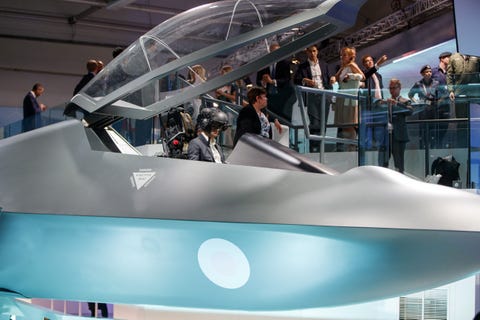U.K. Introduces New Fighter Jet: The Tempest
The fighter exists only in mockup for now, and is expected to enter service in 2035.
By Kyle Mizokami
BRITAIN-AVIATION-SHOW-AEROSPACE-MANUFACTURINGGETTY IMAGESTOLGA AKMEN
The United Kingdom has announced the country’s first entirely British fighter in decades. The new Tempest fighter project will primarily involve British defense contractors, forging a plane that could be used for domestic use and export. The British government says the fighter should be ready for service by 2035.
U.K. Defence Secretary Gavin Williamson introduced a full-sized model of the new Tempest multi-role fighter today at the Farnborough Air Show. The Tempest incorporates a host of new technologies that would surpass what's in the F-35, meaning the British plane would join the growing group of "sixth-generation" fighters now on the drawing board. Several defense correspondents and aviation experts tweeted out some juicy details from briefings, particularly the Royal Aeronautical Society’s Tim Robinson.
One of Tempest’s most important technologies is optional manning, meaning it will be able to fly with a human pilot or without one. Tempest also would be able to direct a group swarming drones, complicating the enemy’s defense and enhancing the plane’s survivability.
Another piece of tech being designed into Tempest (and likely to become standard in future fighters) is so-called “cooperative engagement capability.” That is, the ability to cooperate on the battlefield, sharing sensor data and messages to coordinate attack or defense.
Tempest will have hypersonic weapons that travel Mach 5 or faster at its disposal, presumably in both air-to-air and air-to-ground configurations. The British fighter will also have directed energy weapons with “non-kinetic effects.”
What does that mean? It's a good question. The phrasing seems to rule out cutting and burning weapons like lasers, particularly as the image tweeted by Tim Robinson shows the nose of the aircraft emitting electromagnetic radiation waves instead of a beam. It could mean electromagnetic pulse weapons that disable enemy electronics, or high-powered microwave emitters. There is no evidence so far of a conventional gun mounted on the aircraft.

BRITAIN-AVIATION-SHOW-AEROSPACE-MANUFACTURING
GETTY IMAGESTOLGA AKMEN
“Team Tempest”, the consortium assembled to design and produce the fighter, is led by BAE, formerly known as British Aerospace. Famed engine producer Rolls Royce will provide propulsion. European (and British) company MBDA is set to work on weapons and Italian defense contractor Leonardo will design integrated sensors and electronic warfare.
Why does Britain need a British-made fighter? One word: Brexit. The U.K. voted to leave the European Union in 2016, forcing the country’s government and industry to prepare for an independent future. Royal Air Force Typhoon fighters should start aging out in the early 2030s, and the Tempest fighter will allow London to buy local fighters and support local jobs and industry.
The Tempest jet will also be an important export. It would compete against the recently announced Franco-German European fighter project, an unnamed Japanese fighter project, and whatever planes American, Russian, and Chinese defense contractors will be offering at the point the Tempest becomes reality. An EU independent UK will need world-beating military equipment like the Tempest to remain competitive in what looks like a competitive 2030s fighter jet market.
Tempest is a major commitment for the UK, testing the country’s ability to crank out a first-rank fighter on its own. The project will consume billions in government funding and taking nearly 20 years to bear fruit. If London fails, it will be a stinging blow to the country that produced such legends as the Sopwith Camel, Spitfire, and Lightning—and could spell the end of the country’s fighter industry.
Tempest is named in the tradition of British fighters being named after the weather (Tornado, Typhoon, Tempest), but its ability to be “invisible” to radar, control drone swarms, “talk” to nearby aircraft, and cripple or destroy enemy threats through electromagnetic radiation almost sounds wizardlike, like the wizard Prospero from Shakespeare’s The Tempest.
No comments:
Post a Comment